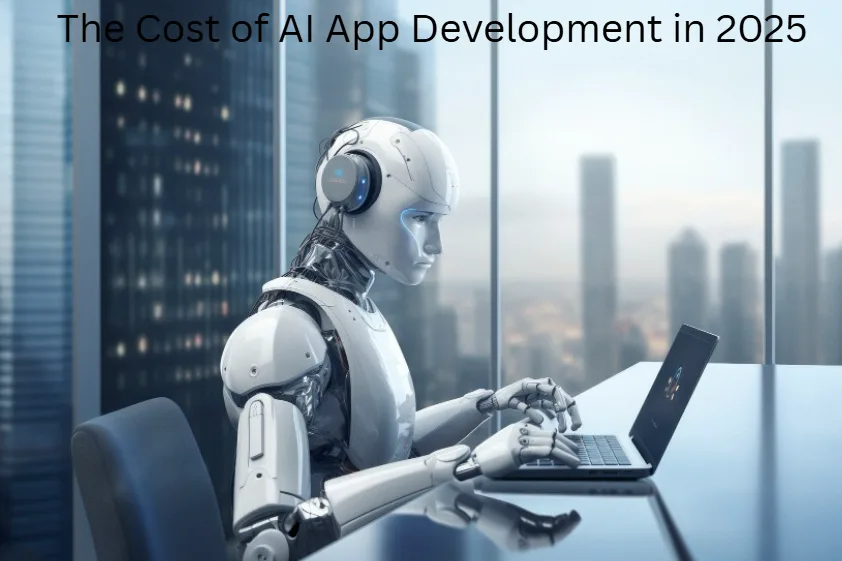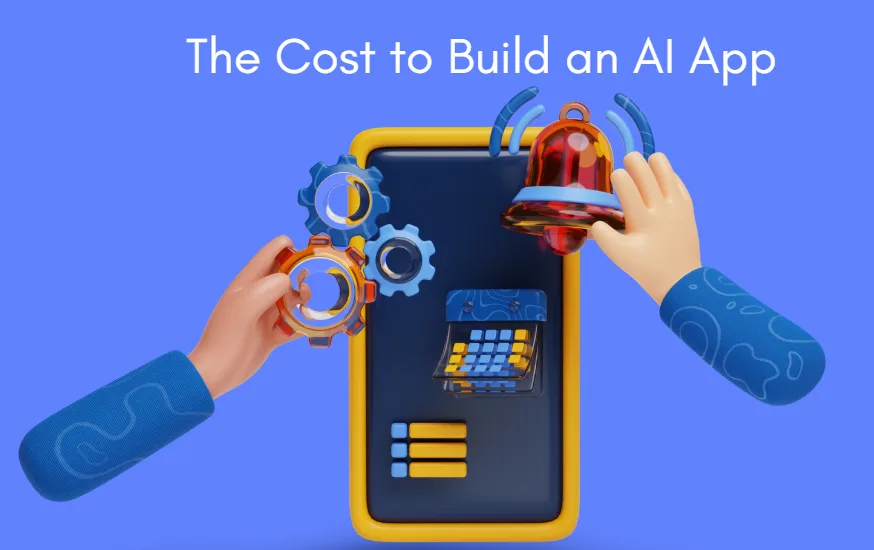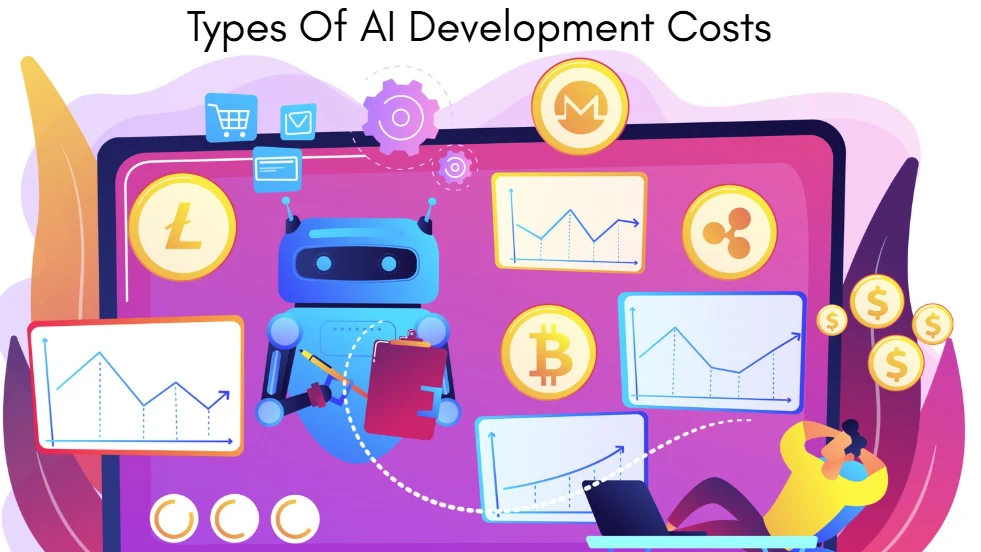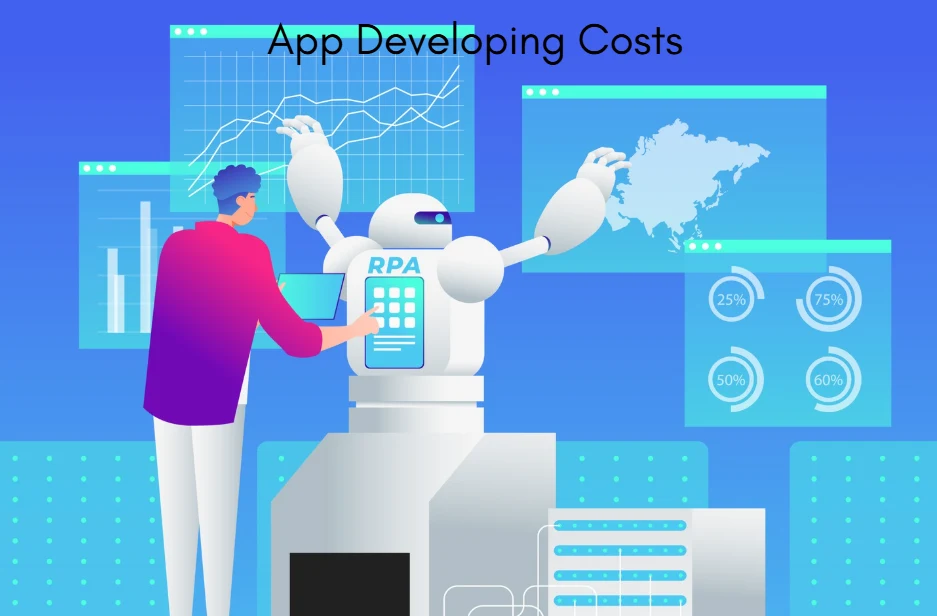What Is the AI App Development Cost in 2025?

As per the 2025 report, the global artificial intelligence market is projected to reach $1.24 trillion by 2030, growing at a 32.9% CAGR. This growth is driven by rising AI adoption across industries like healthcare, automotive, finance, and retail.
Why Companies Are Investing Despite High AI App Development Costs in 2025
The Cost to Develop an AI Application?
| App Type | Development Cost (USD) | Description |
|---|---|---|
| Basic AI App | $30,000–$60,000 | Simple chatbot, image classification, or basic predictive model |
| Medium Complexity | $60,000–$150,000 | Natural Language Processing |
| Advanced AI App | $150,000–$300,000+ | Real-time analytics, deep learning, computer vision, and a personalization engine |
Estimated Average Cost Ranges by AI Project Type
● Basic AI App
Cost: $30,000 – $60,000
Comprises basic chatbots, rule-based logic, or simple image recognition.
● NLP-Powered Chatbot or Voice Assistant
Cost: $50,000 – $120,000
Usage of Natural Language Processing
● Recommendation Engine
Cost: $70,000 – $150,000
Recommend products, content, or services on the basis of user behaviour and preferences.
● Predictive Analytics Platform
Cost: $80,000 – $200,000
Offers AI-based data-driven predictions, insights, and decision support.
● Face/Object Recognition Computer Vision App
Cost: $100,000 – $250,000
It processes images for various purposes, such as recognition, surveillance, and AR (augmented reality).
● AI Model (Custom-Trained from the ground up)
Cost: $150,000 – $300,000+
Involves continuing AI coding, which covers data wrangling, training, and fine-tuning.
● Enterprise-Scale AI App
Cost: $250,000 – $500,000+
Integrates AI components, cloud service, real-time analysis, and integrations.
These numbers will help businesses plan for the costs associated with adopting various scenarios of AI app development.
Curious about what your AI app might cost?
Get a detailed, customized estimate based on your business goals and AI use case.
Breakdown of Costs in Developing AI: Major Expense Areas
1. Data Collection and Preparation
- You spent a lot of your money on collecting, cleaning, categorizing, and storing data
- Finite and Diverse Data: Demand for high-quality data to train accurate AI models.
- If your company doesn’t have structured data, then costs rise through sourcing and preparation.
- Anticipated Cost Share: 15% to 25%
2. Model Selection and Development
- Softwar Developers either adapt a pre-trained AI model or write one from scratch.
- Building a custom model needs deep AI knowledge and more data.
- This stage is critical to the intelligence and performance of your app.
- Cost Share Estimate: 20% – 35%
3. Software Development and Integration
- You have that AI model, and you want to build an app around it via front-end and back-end development.
- Developers create APIs, dashboards, databases, and system configurations.
- Complexity increases as it integrates with your current platforms (CRMs, ERPs Software, mobile apps).
4. Infrastructure and Cloud Services
- Scale Models of some of our AI (more can be found here). Many AI models require cloud resources to perform well.
- Costs cover server space, GPUs for training, API usage, and storage.
- This is done using platforms such as AWS, Azure, or Google Cloud.
- Approximate Federal Cost: 85% – 90% Estimated Non-Federal Cost: 10% – 15%
5. Testing and Quality Assurance
- You need to test the AI app for performance, accuracy, bias, and security.
- This stage comprises the test of components, the validation of the model, and the simulation of cases.
- A good QA process helps you make your app act more reliably in the face of real usage.
- Estimated Dollar Value: 5% – 10%
6. Maintenance and Updates
- You’ve deployed your AI app, and after you need to continually patch it with bug fixes and new model training.
- Developers tune the app against drift, retrain on fresh data, and keep it up to date according to new standards.
An analysis of the AI development cost breakdown will enable you to distribute resources more efficiently and prevent any budget surprises. That is why we have focused on addressing these key areas to make sure that your AI app launches successfully and keeps consistently working as your business scales up.
7 Key Factors That Affect AI App Development Cost
1. App Complexity and Features
Let me further elaborate: The more features you incorporate (e.g., voice interaction, real-time data processing, facial recognition), the more expensive the development is going to be. In addition, heavy AI logic needs a long time for training and testing models.2. Type of AI Model Used
The existing pre-trained models (GPT from OpenAI or BERT from Google) are cheaper, but developing your own AI model from scratch is more time-consuming and costly.3. Data Availability and Preparation
AI apps need quality data. If your business does not have structured data sets, then a developer will need to spend time collecting, cleaning up, and labeling, which increases total development costs.4. App Platform (iOS, Android, Web)
Depending on how much is required to build cross-platform AI apps or hook up to mobile/web APIs. Time and money are usually inflated for native apps on iOS mobile app development.5. Integration with Third-Party Services
If your app has to communicate with CRMs, payment gateways, or analytical tools, the complexity of their integration will increase the cost of AI app development.6. UI/UX Design and Testing
Usability plus rigorous testing are critical, particularly for AI-based features, which need to "do the right thing" in a diverse set of scenarios.How to cut the cost of your AI App Development
- Begin with an MVP: Create a minimum viable product with the core AI functionality
- Pre-Trained Models: Utilize pre-built libraries or APIs instead of building from the ground up.
- Delegate to AI Pro: Employ an expert in the form of app development companies experienced in developing AI apps to save yourself from committing costly blunders.
- Be Scalable: Make sure your architecture can continue to grow (without a lot of re-architecting) into the future.
How to build an AI App Development Cost? Based on the Team

1. Freelancers (Low Cost, High Flexibility)
For startups or short-term project needs, freelancers typically represent the best cost-effective solution. You can hire them task by task or on an hourly basis for specific roles such as UI design, backend development, or AI model integration.
Pros:
- Hourly rates are typically less ($15–$60/hour, based on location and experience)
- Flexible contracts
- Great for small, temporary projects or MVPs.
Cons:
- Limited accountability
- Needs some more project management from you
- May not have experience developing AI apps at scale
- Rough Cost Estimate: $10,000 – $50,000
2. In-House Development Team (High Control, High Cost)
If you’re looking for absolute control over development, hiring an internal team is an excellent option as well. That includes pay, benefits, tools, and facilities.
Pros:
- Better collaboration and real-time communication
- Full alignment with company goals
- Own management in terms of quality and time scheduling
Cons:
- High upfront and ongoing costs
- Time-consuming recruitment process
- Might need to hire multiple roles: AI engineer, backend/frontend developer, UI/UX designer, QA tester, project manager
- Annual Cost: $150,000 – $500,000+, depending on the number of team members and region
3. Local App Dev Shop (Balanced Approach)
An Outsourcing Partner is Authenticated. Hiring a local agency gives you access to a professional team, including project management, technical skills, and end-to-end delivery. You’re part of a large team that comprises AI experts, software developers, and testers.
Pros:
- Professional and coordinated workflow
- High accountability and communication
- Better risk mitigation
Cons:
- Higher hourly rates ($100–$200/hour)
- Inflation in costs by region (with a particular focus on North America, Western Europe)
- Projected Cost: $100,000 to $300,000+
4. Offshore, Outsourced AI Development Company (Cheap, Scalable)
As a result, many companies outsource to trusted AI development companies in places like India, Eastern Europe, and Southeast Asia. Those offer quality at a price that is competitive.
Pros:
- Lower hourly rates ($30–$80/hour)
- Access to global AI talent
- Faster team scaling
Cons:
- Time zone differences
- Requires clear communication and documentation
- Average Project Cost: $30,000 – $150,000
The decision of the team will have both immediate and long-term impacts on your AI app development cost, time to market, and the success of your project. Freelance developers may be great for prototyping, but you want a more scalable and accountable solution. For that, use established agencies or offshore teams instead. The best team for you will depend on your budget, timeline, and the complexity of your app development.
Types Of AI Development Costs

1. Chatbots and Virtual Assistants
- They are AI apps that leverage natural language processing (NLP) to digest and answer user input.
- Pricing is based on volume of responses, languages supported, and integrations.
- Estimated Cost: $20,000 – $80,000
- Sample Use Cases: Customer support, appointment scheduling, live chat automation
2. Image and Video Recognition Apps
- These applications leverage computer vision to recognize objects, faces, or actions in the real world.
- The cost of development increases with GPU utilization and training data.
- Estimated Cost: $50,000 – $200,000
- Application: Security, Healthcare, Imaging, Quality control of manufacturing
3. Recommendation Systems
- AI suggests products, content, or actions based on the way users behave and the data is analyzed.
- Our cost depends on the size of the data and the complexity of the personalization algorithm.
- Estimated Cost: $60,000 – $150,000
- Use Case Scenario: E-commerce, media platform, learning management system
4. Predictive Analytics Platforms
- Such solutions predict trends, dangers, or desires based on past behavior.
- Projects need a lot of heavy data modelling and optimization.
- Estimated Cost: $80,000 – $200,000
- Sales forecasting, customer churn prediction, and risk management are examples of use cases.
5. Speech Recognition and Voice AI
- Orderly AI apps that work on voice, change the voice into text by entering data into the app, and make audio interaction.
- There are costs associated with multi-language support and with real-time audio processing.
- Estimated Cost: $70,000 – $180,000
- Applications: Smart home apps, voice assistants, transcription tools
6. Generative AI Applications
- These apps generate new material by feeding advanced models with existing ones, such as text, image, music, or code.
- As the computation and tuning are very heavy, they are the costliest to compute.
- Estimated Cost: $100,000 – $300,000+
- Examples: AI content creators, image generators, code writing assistants
Determining how an AI app should cost depends on the kind of AI it is that you’re building. Some involve very little learning and integration, while others involve massive data sets, model complexity, and cloud infrastructure. Knowing the cost by type of an app can let you make the right strategy decision and use your development budget intelligently.
App Developing Costs That Could Be Hiding From You

1. API and Third-Party Service Fees
Most AI apps use external API access, for something as simple as payment processing, mapping, or analytics, or an AI model (that you tell to an API like GPT, or AWS AI services). These are usually subscription-based tools with monthly usage fees that grow as your app scales.
You pay for:- API calls beyond free limits
- Premium plans for AI features
- High-usage cloud service charges
Tip: Never forget to add in ongoing API costs when budgeting your AI app development costs.
2. Cloud Infrastructure and Hosting
AI applications usually require cloud resources to host models, store data, and provide distributed, real-time content. As usage surges, so do your corresponding costs on compute power, data storage, and bandwidth.
You will spend on:- Hosting (AWS, Google Cloud, Azure DevOps)
- GPU time for model training or inference
- Data backup and content delivery networks
Tip: Cloud costs are variable, ongoing, and increase based on your user base and the complexity of your application.
3. Retraining and Optimizing Your Models
If your application contains machine learning or deep learning applications, you must retrain your AI models frequently to remain accurate and relevant. Retraining means time, computing resources, decisions, and expertise.
The hidden costs can include:- Data labeling and cleansing
- Engineering time to tune the model
- A/B testing and performance verification
Tip: Develop a timetable for model updating as part of a long-term AI maintenance strategy.
4. Store Fees and Commissions
When you launch your AI app on the Apple App Store or Google Play Store, you will pay fees just to launch in those locations.
You can expect:- Developer account fees ($25 one-time for Android and $99/year for iOS)
Tip: Consider these platform costs if your monetization relies on mobile downloads.
5. Security, Compliance, and Legal Costs
If your app will be taking sensitive user information (think medical applications, financial applications, education), you will have to follow regulations like GDPR, HIPAA, or CCPA. This will lead to spending on cybersecurity tools for protection, legal work, and compliance fees.
Common spending:- Data encryption and privacy tools
- Secured authentication systems
- Legal fees/dissemination for updates
Tip: Don't cut corners on compliance; if you're caught, there can be fines and trust issues—this should be in your scope of development.
6. App Maintenance and Bug Fixes
After launch, you need to maintain your app with bug fixes, OS compatibility fixes, and system health monitoring. Maintenance is not a small one-time cost, but an ongoing fee for keeping your app running.
What to fund:- Monthly developer or app developer work (hours)
- Emergency bug patching and updates
- OS and device updates compatibility checks
7. User Support and Training
As your number of users grows, you will need some sort of support system (help desk, FAQs, live chat, etc.). If your app is for an enterprise, you will likely have to train the teams internally regarding AI features.
You will be spending on:- Support staff or outsourced agents, knowledge base creation
- Onboarding and user training tools
Tip: Providing great support will enhance retention, so make sure to include it in your post-launch budgeting.
Thinking through AI app development requires that you consider everything beyond just code and design. You'll want to keep in mind the ecosystem in its entirety—infrastructure, compliance, what happens after your launch, and user support—needed if you want to create a trustworthy and scalable product.
Maximizing AI App Development Costs
Developing an AI app doesn't have to put you in the red. You can minimize your overall AI app development costs if you have a good plan, use the right technologies, and work with a capable team. Below are great methods to maximize your spending during your AI app development.
1. Set Goals Upfront
It's best practice to have goals and use cases set before development begins. Setting a defined purpose allows your team to avoid misalignment and scope creep.
2. Use a Minimum Viable Product (MVP)
You will receive valuable real user feedback early on and be able to scale for users' needs.
3. Take Advantage of Pre-Trained Models/APIs
Take advantage of available AI models like GPT, BERT, or Google Vision, avoiding development costs and time to build your own AI frameworks.
4. Leverage an Experienced Development Team
Using an overseas AI development team can save you an exceptional amount of money and quality. Several talented agencies give you flexible scaling pricing models that will not impede your pace of delivery or innovation.
5. Automate the Testing and Quality Assurance
You can use automated testing tools, which can help find bugs quickly and allow you to update your app with less downtime.
6. Select a Scalable and Cloud-Based Infrastructure
Instead of pouring money into hardware, let your AI app live in the cloud. Things like AWS, Azure, or Google Cloud can help you scale your needs when you want, while being able to keep infrastructure costs in check.
7. Plan for Long-Term Maintenance Early
Don't think of maintaining your AI app as an afterthought. From the start, you should focus on how you can upgrade your app. Building things in a modular way and maintaining clean code will make it easier for you to maintain and scale later, and will avoid the risk of having to throw away existing work in the future.
8. Use an Agile Development Framework
Agile takes a different approach to AI software development Company to give your team the ability to build out the product in multiple iterations or short sprints. This allows the team to detect problems sooner, modify applications in a faster manner, and avoid bottlenecks or lost time.
Building a successful AI app does not require an unlimited budget. If you plan strategically and put the right tools and workflows in place, you can optimize AI app development costs significantly. Focus on delivering value sooner, only scale when necessary, and collaborate with professionals who know what they are doing to make the most of every dollar that you invest.
Conclusion
No matter if you are designing an AI Development Company in India for a virtual assistant, an AI chatbot, or an AI app that uses predictive analytics from data, you must understand that picking the right app development strategy is crucial to your success and your return on investment, and managing your AI app development cost effectively.
Ready to Build a Scalable AI App in 2025?
Rytsense Technologies helps businesses like yours build intelligent, cost-effective AI applications that deliver long-term value.

The Author
Karthikeyan
Co Founder, Rytsense Technologies